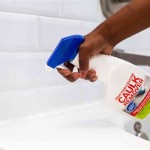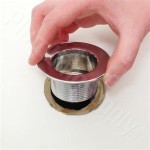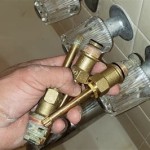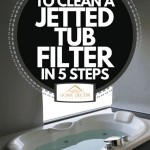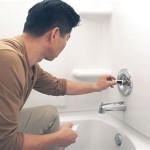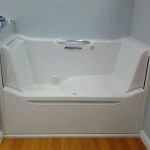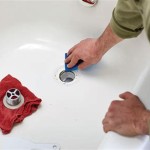How To Drain a Bathtub Clogged With Hair
A clogged bathtub drain is a common household problem, often caused by the accumulation of hair, soap scum, and other debris. The slow draining or complete blockage of water can be frustrating and inconvenient. Addressing the issue promptly is crucial to prevent further inconvenience and potential damage to plumbing systems. This article outlines several effective methods for clearing a bathtub drain clogged with hair, ranging from simple, readily available solutions to more involved techniques.
It's important to note that while these methods are generally safe, caution should be exercised to avoid damaging the bathtub's finish or the plumbing itself. Always test any cleaning solutions in an inconspicuous area first to ensure they do not cause discoloration or etching. Furthermore, if the clog persists despite multiple attempts, consulting a professional plumber is recommended to avoid exacerbating the problem.
Using Boiling Water
One of the simplest and often effective methods for clearing a minor hair clog is using boiling water. The heat from the boiling water can help to dissolve soap scum and loosen the hair, allowing it to flush through the drain. This method is particularly effective for clogs that are not deeply embedded in the drainpipe.
To use this method, carefully pour a kettle or pot of boiling water directly down the drain. It is essential to exercise caution to avoid burns from splashing water. Allow the boiling water to sit for a few minutes, then run hot tap water for a few minutes to see if the drain clears. If the drain is still slow, repeat the process. This method is generally safe for most types of pipes, but it's important to avoid using boiling water if the bathtub is made of porcelain or has PVC pipes, as the extreme heat could potentially damage these materials. In such cases, use very hot, but not boiling, water.
The effectiveness of boiling water is dependent on the composition of the clog. It is most effective when the clog is primarily composed of soap scum and loose hair. For more dense and compacted clogs, other methods may be necessary.
Employing a Plunger
A plunger is a common household tool that can be effective in dislodging clogs in bathtub drains. The plunging action creates pressure that can help to break up and move the blockage. This method is most effective when there is sufficient water in the tub to create a seal around the drain.
To use a plunger effectively, begin by removing the drain stopper. If the stopper cannot be removed, ensure it is in the open position. Add enough water to the bathtub to cover the cup of the plunger. Create a tight seal around the drain opening with the plunger cup. Push and pull the plunger up and down with a consistent, forceful motion for several minutes. Maintain the seal throughout the process. After several minutes of plunging, lift the plunger to see if the water drains. If the water drains freely, the clog has likely been cleared. If the drain remains slow or blocked, repeat the process.
There are two main types of plungers: cup plungers and flange plungers. Cup plungers are generally used for flat surfaces, such as bathtubs and sinks, while flange plungers have a soft rubber flap that folds out from the cup and are designed for toilets. Using the correct type of plunger is crucial for creating a proper seal and maximizing the effectiveness of the plunging action.
When plunging, it's important to avoid excessive force, which could potentially damage the drainpipe or the bathtub itself. A consistent and rhythmic motion is generally more effective than aggressive plunging. If the clog is particularly stubborn, try alternating between pushing and pulling motions to help dislodge the blockage.
Using a Wire Coat Hanger or Drain Snake
A wire coat hanger or a drain snake (also known as an auger) can be used to manually remove hair and debris from the bathtub drain. These tools allow for direct access to the clog and can be effective in pulling out or breaking up the blockage.
To use a wire coat hanger, straighten the hanger as much as possible, leaving a small hook at the end. Carefully insert the hooked end of the hanger into the drain opening. Gently probe around to feel for the clog. Once the clog is located, try to hook and pull out the hair and debris. Remove the hanger and clean off any hair or debris that has been retrieved. Repeat the process until no more debris can be pulled out.
A drain snake is a more specialized tool designed specifically for clearing drains. It consists of a flexible metal cable with a corkscrew or brush-like end. To use a drain snake, carefully insert the cable into the drain opening. Rotate the handle to advance the cable through the drainpipe. As the cable encounters the clog, the corkscrew or brush end will help to break up or grab onto the hair and debris. Continue rotating and advancing the cable until it has passed through the clog. Then, slowly retract the cable, removing any hair or debris that has been retrieved. Repeat the process until the drain is clear.
When using a wire coat hanger or drain snake, it's important to avoid forcing the tool too forcefully, as this could damage the drainpipe. Work slowly and carefully, and try to gently loosen the clog rather than pushing it further down the drain. After using either tool, flush the drain with hot water to remove any remaining debris.
Baking Soda and Vinegar Solution
A mixture of baking soda and vinegar is a natural and often effective solution for clearing clogged drains. The chemical reaction between these two substances creates a fizzing action that can help to break up grease, soap scum, and hair.
To use this method, first pour one cup of baking soda down the drain. Follow this with one cup of white vinegar. The mixture will begin to fizz and foam. Allow the mixture to sit for at least 30 minutes, or preferably overnight, to allow the chemical reaction to fully work on the clog. After the allotted time, flush the drain with hot water.
For particularly stubborn clogs, you can repeat the baking soda and vinegar treatment. You can also try using a larger amount of baking soda and vinegar. However, it's important to avoid using excessive amounts of either substance, as this could potentially damage the drainpipe.
The baking soda and vinegar method is generally safe for most types of pipes, but it's always a good idea to test the solution in an inconspicuous area first to ensure it does not cause any discoloration or etching. This method is most effective for clogs that are primarily composed of grease and soap scum. For dense hair clogs, other methods may be necessary.
Using a Wet/Dry Vacuum
A wet/dry vacuum can be a powerful tool for removing clogs from a bathtub drain. By using the vacuum's suction, it's possible to extract the blockage directly from the drainpipe.
To use this method, first, ensure that the vacuum is set to the wet setting. Remove the drain stopper. Cover the overflow drain with a wet cloth to create a seal and maximize suction through the main drain. Place the vacuum hose over the drain opening, creating as tight a seal as possible. Turn on the vacuum and let it run for several minutes. Check the vacuum's collection tank to see if any hair or debris has been extracted. Repeat the process until the drain is clear.
It's important to maintain a good seal between the vacuum hose and the drain opening to maximize the suction force. If the seal is poor, the vacuum will not be as effective in removing the clog. You can use duct tape or a wet cloth to help create a tighter seal.
After using the wet/dry vacuum, flush the drain with hot water to remove any remaining debris. This method is generally effective for removing a variety of clogs, including hair, soap scum, and other debris. However, it may not be effective for very large or deeply embedded clogs.
Commercial Drain Cleaners
Commercial drain cleaners are chemical solutions designed to dissolve clogs in drains. They are available in various formulations, including liquid, gel, and crystal forms. While they can be effective, they should be used with caution due to their potentially corrosive nature. Always carefully read and follow the manufacturer's instructions when using commercial drain cleaners.
To use a commercial drain cleaner, pour the recommended amount down the drain. Allow the cleaner to sit for the specified period of time, usually between 15 and 30 minutes. After the allotted time, flush the drain with plenty of cold water. Avoid using hot water, as the heat could potentially react with the chemicals in the drain cleaner and create harmful fumes.
It's crucial to wear protective gloves and eye protection when using commercial drain cleaners to avoid skin and eye irritation. Ensure that the area is well-ventilated to minimize exposure to fumes. Never mix different types of drain cleaners, as this could create dangerous chemical reactions. Also, avoid using drain cleaners repeatedly, as they can damage pipes over time.
If the first application of the drain cleaner does not clear the clog, it's best to try another method or consult a professional plumber. Repeated use of drain cleaners can weaken pipes and cause leaks. It's also important to keep drain cleaners out of reach of children and pets due to their toxic nature.
Alternative, more eco-friendly drain cleaners are also available, often utilizing enzymes or bacteria to break down organic matter. These are typically less harsh on pipes and the environment.
Preventative measures are ultimately the best way to avoid bathtub clogs. Regularly cleaning the drain stopper and using a hair catcher can significantly reduce the amount of hair and debris that enters the drainpipe. Periodically flushing the drain with hot water can also help to prevent the buildup of soap scum and grease.

How To Unclog Most Bathtub Drains By Removing Hair

5 Easy Ways To Unclog Bathtub Drain

How To Unclog Bathtub Drain Full Of Hair Stellar Plumbing

Top 5 Ways To Get Hair Out Of Your Drains

How To Clean Hair Out Of A Shower Drain 9 Easy Ways

How To Unclog Bathtub Drain Full Of Hair

How To Unclog A Bathtub Drain Without Chemicals

How To Clean Hair Out Of A Shower Drain 9 Easy Ways

How To Unclog A Bathtub Drain Without Chemicals Family Handyman

How To Easily Unclog Bathtub Shower Drain In 5 Minutes Jonny Diy
Related Posts

